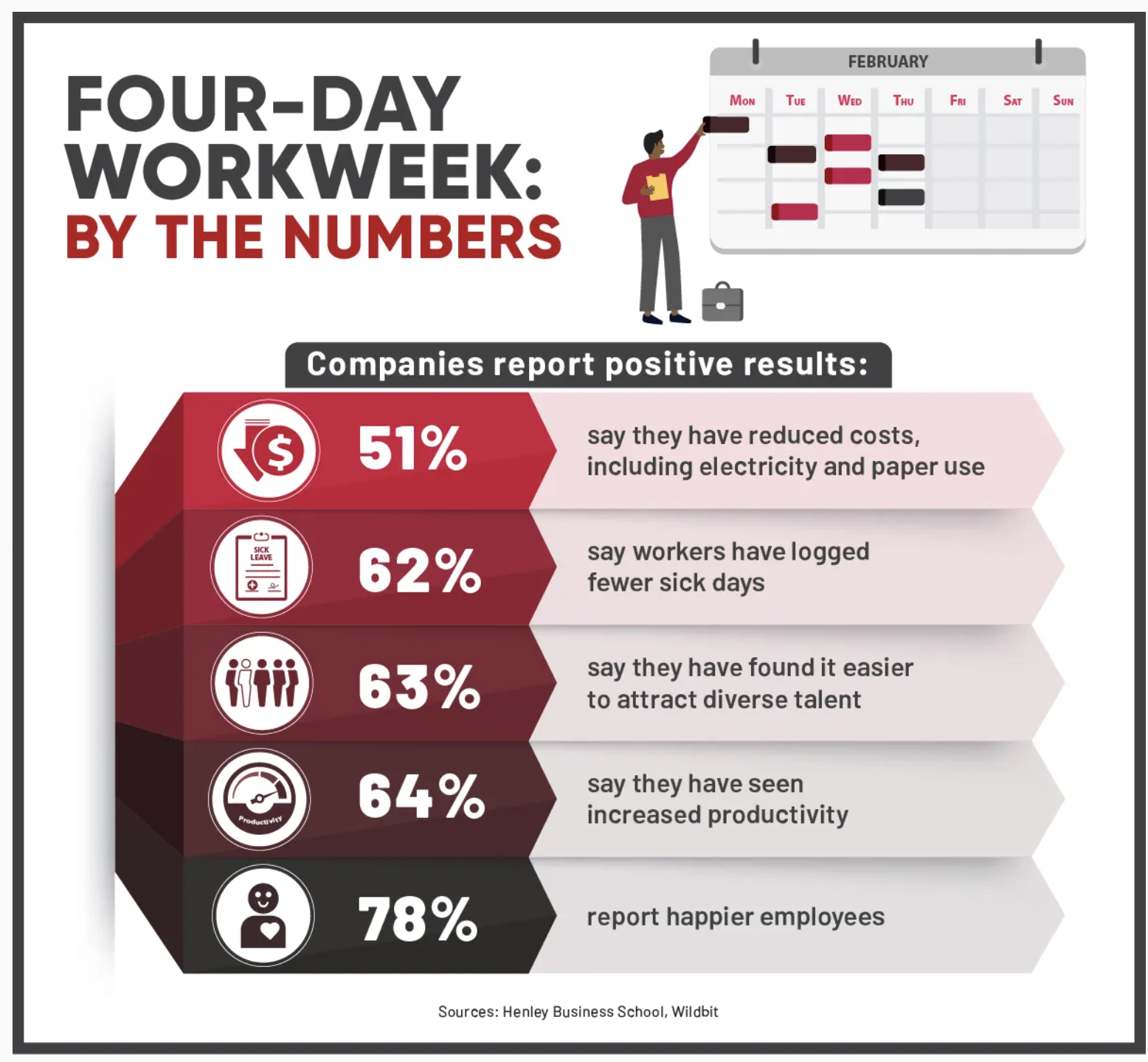
The Pros and Cons of a 4-Day Workweek
For over a century, the U.S. has adhered to the standard 40-hour workweek. However, in recent years, the notion of a four-day workweek has gained traction as a potential solution to the challenges of traditional work schedules. As the pursuit of work-life balance intensifies, many are curious – is a 4-day workweek feasible, and are U.S. companies embracing this alternative approach?
Historical Context

Though the 40-hour workweek became standardized in 1926 by Henry Ford, societal shifts and technological advances have prompted a reassessment of this norm. The once-radical idea of a four-day workweek is now viewed as a practical means to enhance work-life balance. While adoption rates vary, progressive companies are starting to embrace this paradigm shift and workers have shown a positive response.
Pros and Cons of a 4-Day Workweek
The benefits of a 4-day workweek are clear –– it fosters improved work-life balance, boosts productivity, and aids in talent attraction and retention. Yet, operational challenges, longer workdays, and communication issues pose obstacles. Balancing these advantages and drawbacks is vital for successful integration.
Flexibility and Collaboration
As work dynamics evolve, the clash between companies advocating for in-office presence and employees seeking flexibility has intensified. The 4-day workweek offers a middle ground, catering to both sides. It provides dedicated office time for collaboration while also allowing remote or hybrid work options, appealing to a diverse workforce.
Employee Satisfaction and Well-being
With the rising demand for flexibility and autonomy, particularly among millennials and Gen Z, the 4-day workweek emerges as a compromise. It condenses work schedules without compromising productivity, boosting employee satisfaction and acknowledging diverse work preferences.

A Fall 2023 survey by Bankrate.com revealed, 83% of workers between the ages of 18-42 say they’d support a four day workweek, with almost 59% strongly supporting it. Their older counterparts are interested as well. Close to 8 in 10 Gen X and Baby Boomers (or 78% between the ages of 43 and 77) support a four-day workweek. But it is younger workers who have indicated they are willing to go to greater lengths for the schedule – more than 9 in 10 of Gen Z and millennial workers who prefer a f4-day workweek (or 92 percent) would still be willing to work that schedule if it meant giving something up, versus 86 percent of Gen X and Baby Boomers. The talent is speaking up and employers are starting to listen.
Recruiting and Retaining Talent
Competitive organizations must adapt to the changing preferences of the workforce. Remote work and hybrid work options have become crucial factors in recruiting and retaining top talent. Workers no longer want a rigid 9 to 5, five-day-a-week scheme. Companies that offer flexibility in work arrangements, such as the 4-day work week, gain a competitive edge in attracting skilled professionals and are more likely to win the war for talent. Polled workers said they would be willing to take a pay cut for a four day workweek, with 16% of those polled agreeing to a pay cut of 20%.
Example of a Typical 4-Day Workweek
A typical four-day workweek might involve employees working four ten-hour days, from Monday to Thursday, with Fridays off. This schedule allows for extended weekends, providing employees with more time for personal pursuits, family, and relaxation while maintaining productivity throughout the workweek. In the U.S., many employers have already implemented a four-day week with success. According to Tech.co, some of these 4-day workweek companies include: Amazon, BigLaw, CARFAX, Forbes Advisor, Kickstarter. Lamborghini, Microsoft, Samsung and Toshiba to name a few.
It has been noted that the tradition of long workweeks or the workaholic mindset contributes to burnout and stress. A condensed schedule of a 4-day workweek allows for longer weekends, enabling crucial rest and rejuvenation. Reduced burnout not only enhances individual well-being but also elevates workplace productivity and morale, while helping to retain and engage a skilled workforce.
The Road Ahead
The feasibility of a 4-day workweek depends on industry demands and organizational structures. Pilot programs and legislative initiatives, like those now being considered by California, Massachusetts, Missouri, Texas, Vermont and Pennsylvania, offer valuable insights.
One study of a 32-hour week in 33 companies in the U.S., Australia, Ireland, the United Kingdom, New Zealand and Canada revealed:
• 87% (two-thirds) of employees felt less burned out with no significant increase in workload during the trial period
• 96.9% wanted to continue the schedule

Recent proposals, including one by Vermont Senator Bernie Sanders, The 32-Hour Workweek Act would reduce the standard work week from 40 hours to 32.” It signals a growing recognition of the need for work week reform in the U.S. NBCBoston.com quotes Sanders, “Today, American workers are over 400 percent more productive than they were in the 1940. And yet, millions of Americans are working longer hours for lower wages than they were decades ago. That has got to change. The financial gains from the major advancements in artificial intelligence, automation and new technology must benefit the working class, not just corporate CEOs and wealthy stockholders on Wall Street.”
In the U.K. where a four day workweek has already met with success, a white paper by Henley Business School offered these important metrics from the companies who have instituted the schedule.

As we navigate modern work culture, the 4-day workweek emerges as a catalyst for change. Prioritizing employee well-being and organizational flexibility can lead to a more sustainable future. Whether the 4-day workweek becomes mainstream or remains experimental, ongoing dialogue reflects the evolving nature of work in the U.S.
Are you an employer looking for an innovative way to recruit talent or implement a 4-day workweek solution? We welcome a conversation to review the benefits of such schedules along with ways to augment your workforce through contract talent. Let’s talk.
******************************
